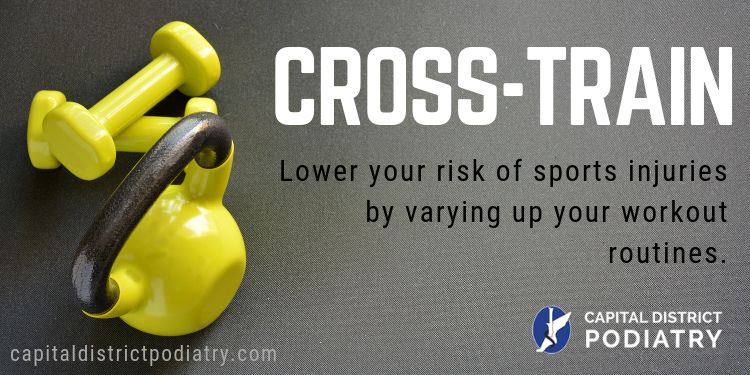Cross-Train to Lower Sports Injury Risk
No matter what your favorite physical activities might be, here’s something that holds true:
We want you to stay safe and healthy while you do them!
Sure, you’re always welcome to come see us for professional foot care if you need it—but we’d much rather know that you didn’t get hurt in the first place.
When it comes to physical activities—and specifically sports and exercises—the simple fact of the matter is that there’s bound to be a certain degree of injury risk. Further, since you use your feet and ankles for a vast majority of activities, you also have a chance that you might hurt one of them.
Now, even though you cannot completely eliminate all injury risk, there are measures you can take to at least reduce it.

One injury prevention measure we want to focus on is cross-training. (We’ll also share a couple more later as well!)
Cross-training is particularly beneficial for lowering your risk of chronic foot and ankle injuries.
So what do we mean by “chronic”? Well, you can think of sports injuries as falling into two general categories:
- Acute injuries – This kind of injury refers to ones that usually happen in a single incident and are fairly unavoidable. They are often the result of some kind of accident, and can cause immediate pain and damage in the lower limbs. You will likely lose at least some strength or mobility in the affected limb, which makes it difficult (or impossible, depending on the specific injury) to continue in a sport or exercise program until you’ve healed.
- Chronic injuries – As opposed to acute injuries, chronic ones develop when tissues in the feet have been overworked and are no longer able to efficiently handle physical stress. This may happen if you change your training program suddenly (or start a new one) without giving your body time to adjust. It also happens for those who over-train. As a result, pain will start to develop, usually increasing over time as the injury worsens.
Now that you have a basic idea as to what is entailed with chronic, overuse injuries, let’s delve into what is meant by cross-training.
Essentially, this is the practice of switching between different types of exercises in a workout program, instead of adhering to a single activity.
Why would anyone want to do this?
Well, there are several reasons for cross-training, such as working your body in a variety of different ways (instead of the same way consistently from a single exercise). This can lead to more-balanced overall health and wellbeing.
Another reason people cross-train is to avoid boredom. Some people are fine with running exclusively as their choice in exercising. Others, however, find this practice to be dull and want more variety. Those individuals would definitely benefit from a rounded exercise program.
Going back to our theme of injury prevention, an outstanding reason to cross-train is to lower your risk of developing a chronic foot or ankle condition.
Individuals who run too often or for great distances place tremendous amounts of physical force and strain upon their lower limbs. This can lead to injuries like stress fractures, plantar fasciitis, and Achilles tendinitis (to name just a couple).
In spite of potential injury risk, running has numerous health benefits. So, you don’t have to consider giving it up entirely!
You can find some middle-ground by supplementing a couple of running days with some low-impact exercises every week.
So, what exactly are low-impact exercises?
Generally speaking, an exercise can be considered low-impact if your joints—and especially the ones in your lower body—are not required to endure tremendous force loads when you perform it.
Specific examples of low-impact exercises you may want to include in your training program are:
- This particular exercise provides a tremendous cardiovascular workout, while at the same time avoiding excessive pressure on your feet and ankles. Even better, it allows you to spend time outside, just as you would when you go running.
- Swimming provides a total body workout. As you swim laps, you burn many calories and enhance your cardiovascular fitness. This can help you shed unwanted, excess pounds, while at the same time promoting healthy blood flow and forcing muscles to burn oxygen more efficiently.
Beyond those other benefits, swimming is a low-impact activity, which means you receive an abundance of health benefits—but without placing excessive strain on the joints in your lower limbs. The low-impact nature of swimming makes it a great exercise to incorporate into a cross-training program.
- If you are interested in a low-impact activity that is conducive to improved flexibility, range-of-motion, and muscle strength—all of which are very important if you suffer from an arthritic condition—yoga could be an outstanding choice for you. Given its popularity, you probably won’t even have to go far to find a yoga studio near you.
- When it comes to exercises, running might receive all the glory, but don’t look past walking— especially as you develop your cross-training plan to supplement your normal running program!
If you’re already in pretty good shape, walking might not seem like much of a challenge, but it provides more physical, emotional, and mental benefit than you probably realize. (Walking is a vastly underrated form of exercise!) Further, you can do it without placing as much stress on your lower limbs as you do when running.
- You don’t have to train like a professional football player or Olympic weightlifter when you lift weights to supplement your running program! (Actually, it’s probably best if you don’t…) Instead, your goal should simply be to strengthen the various muscle groups in both your upper and lower body. Doing so will reduce your risk of developing stress fractures, since stronger muscles in the feet and legs can better help your bones absorb force loads.
These are all outstanding low-impact activities that can help lower your injury risk (when incorporated into a proper cross-training program). Something to keep in mind, though, is that you can potentially get hurt doing just about anything. This is simply part of being a human in a physical body. After all, you could even possibly sprain an ankle when walking across the parking lot as you go to your yoga class!
Of course, it’s important to remember that your goal is to reduce your injury risk—not eliminate it completely (which is impossible).

Some other ways you can further minimize your risk of hurting a foot or ankle include:
- Consider your shoes. Make sure you start off any physical activity by wearing appropriate footwear. Whereas it’s possible to run a marathon in a pair of loafers, you will likely end up with more pain and problems than you ever hope to have. Also, your shoes need to fit will. That means they shouldn’t be too loose, nor too tight!
- Ease into new physical activities. It’s great to be excited about a new workout program and your dedication to getting into shape—but remember that doing “too much, too soon” is often a recipe for injury and difficulty. Instead, start at a relatively easy level and gradually ramp up the intensity and duration.
- Stretch! If you start an activity with cold, tight muscles, you’re opening the door for potential injury. A better approach is to warm up with 5-10 minutes of brisk walking or light jogging, and then follow that with some dynamic stretches. This will prepare your body for action!
As we noted earlier, our hope is that you are able to stay safe and healthy when you work out. At the same time, we know firsthand that foot and ankle injuries can happen—even if you take the best possible precautions.
In the event you do need care for a foot or ankle sports injury, keep in mind that Capital District Podiatry is right here for you. Just give us a call at (518) 273-0053 and we’ll set you up with an appointment so you can get started on your road to recovery!
Troy Office
763 Hoosick Rd.
Troy, NY 12180
Clifton Park Office
855 Route 146 | Suite 150
Clifton Park, NY 12065
© Capital District Podiatry, LLC. All Rights Reserved.
Notice of Nondiscrimination | Privacy Policy | Terms & Conditions
